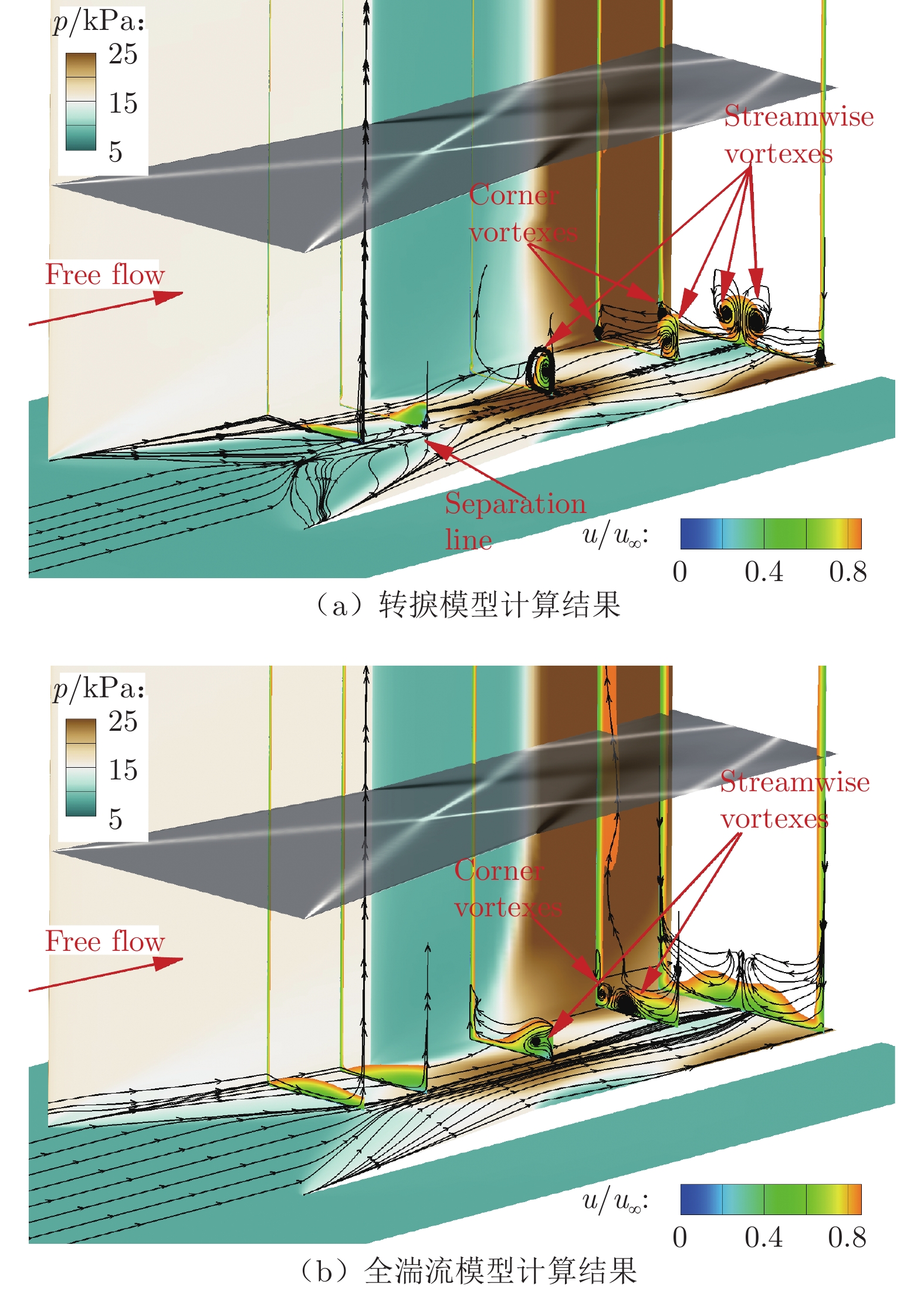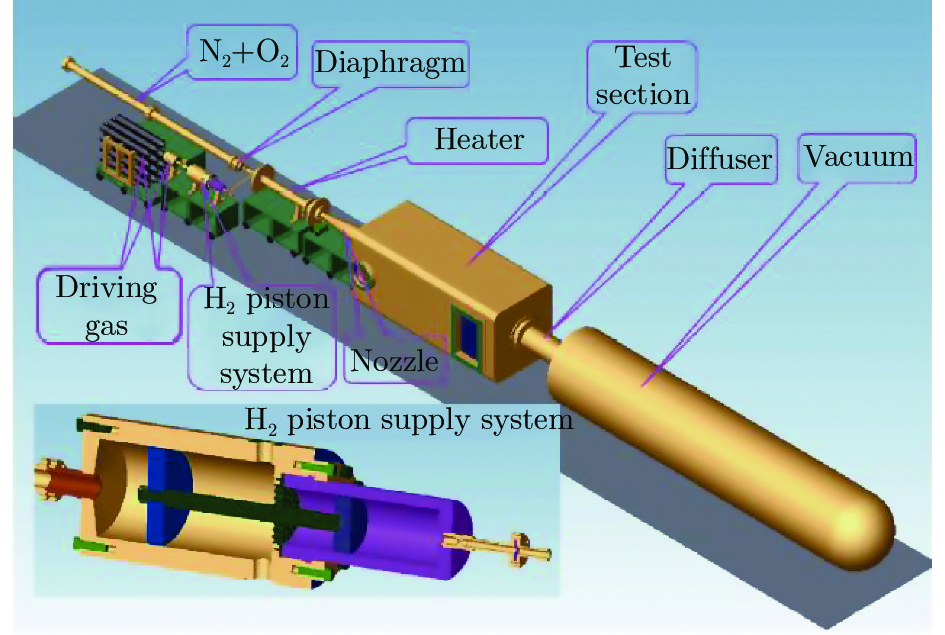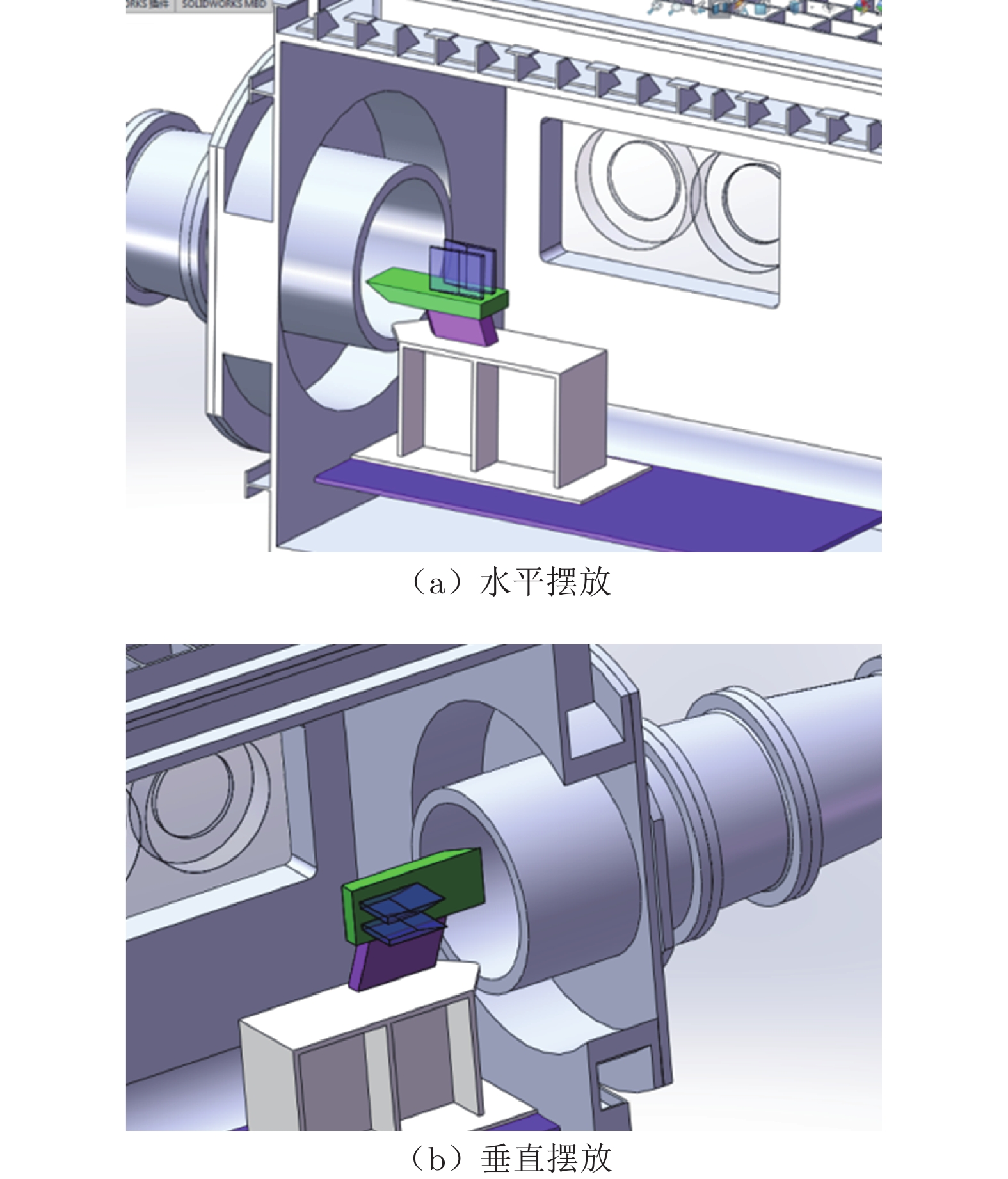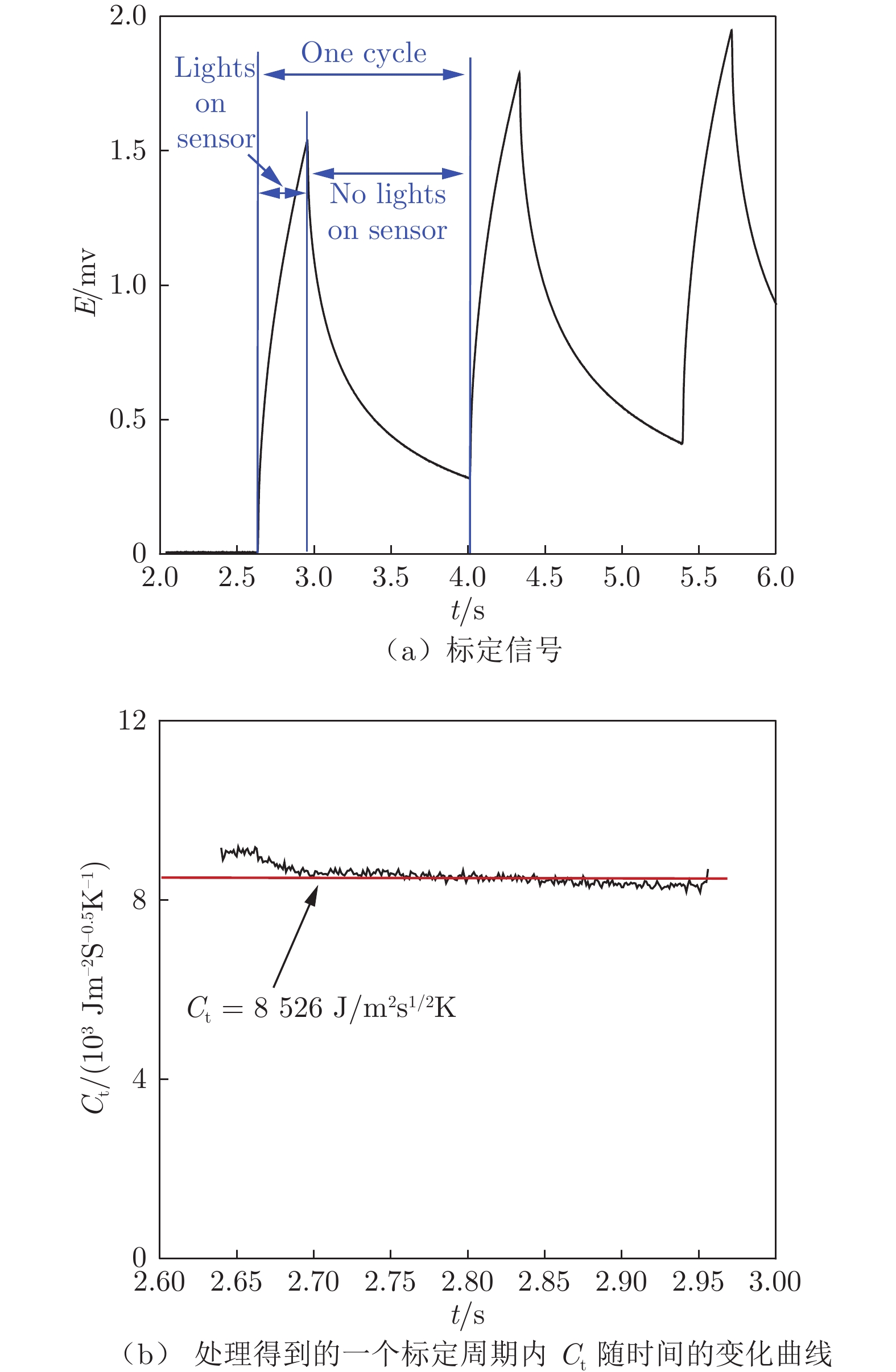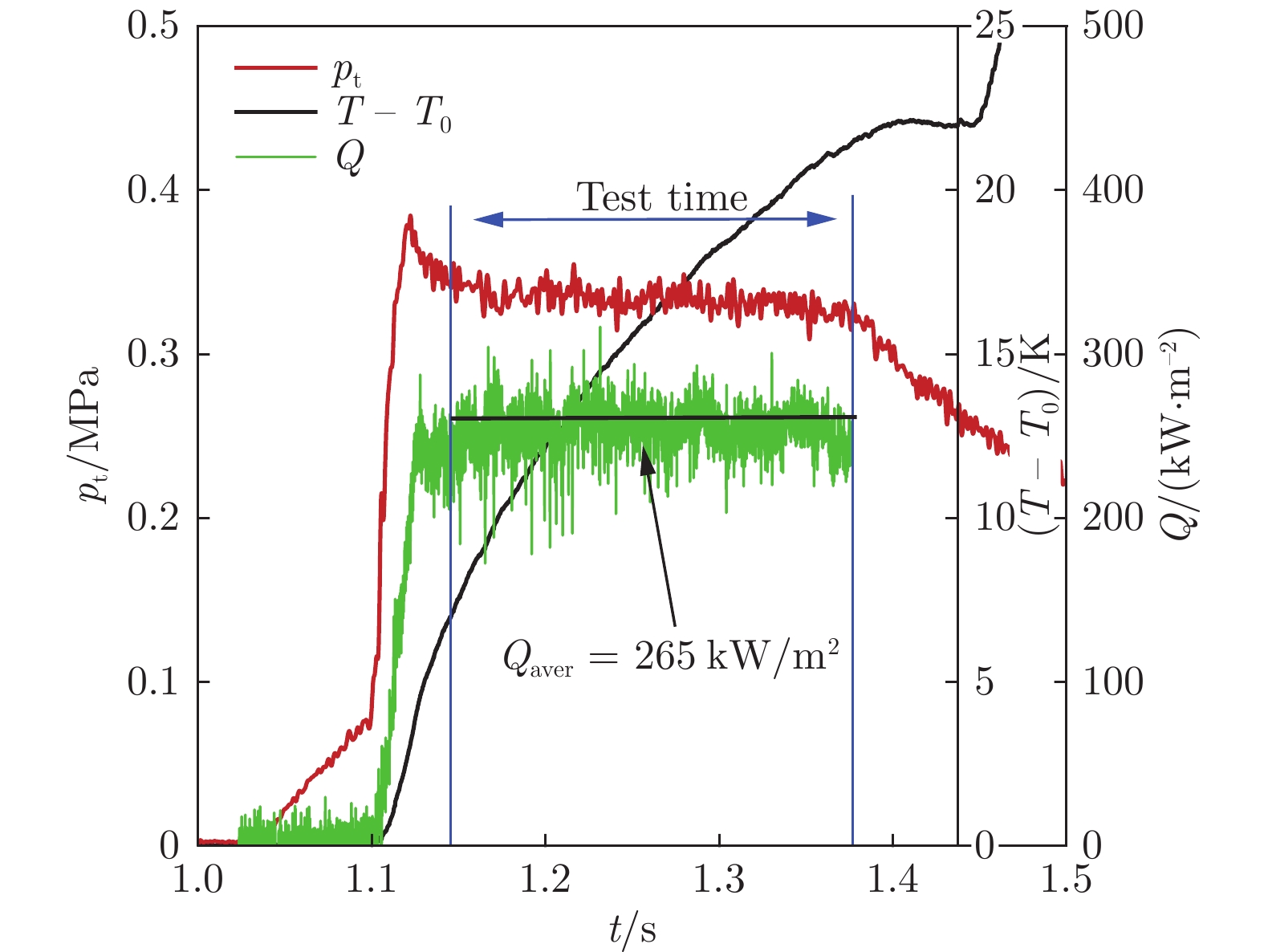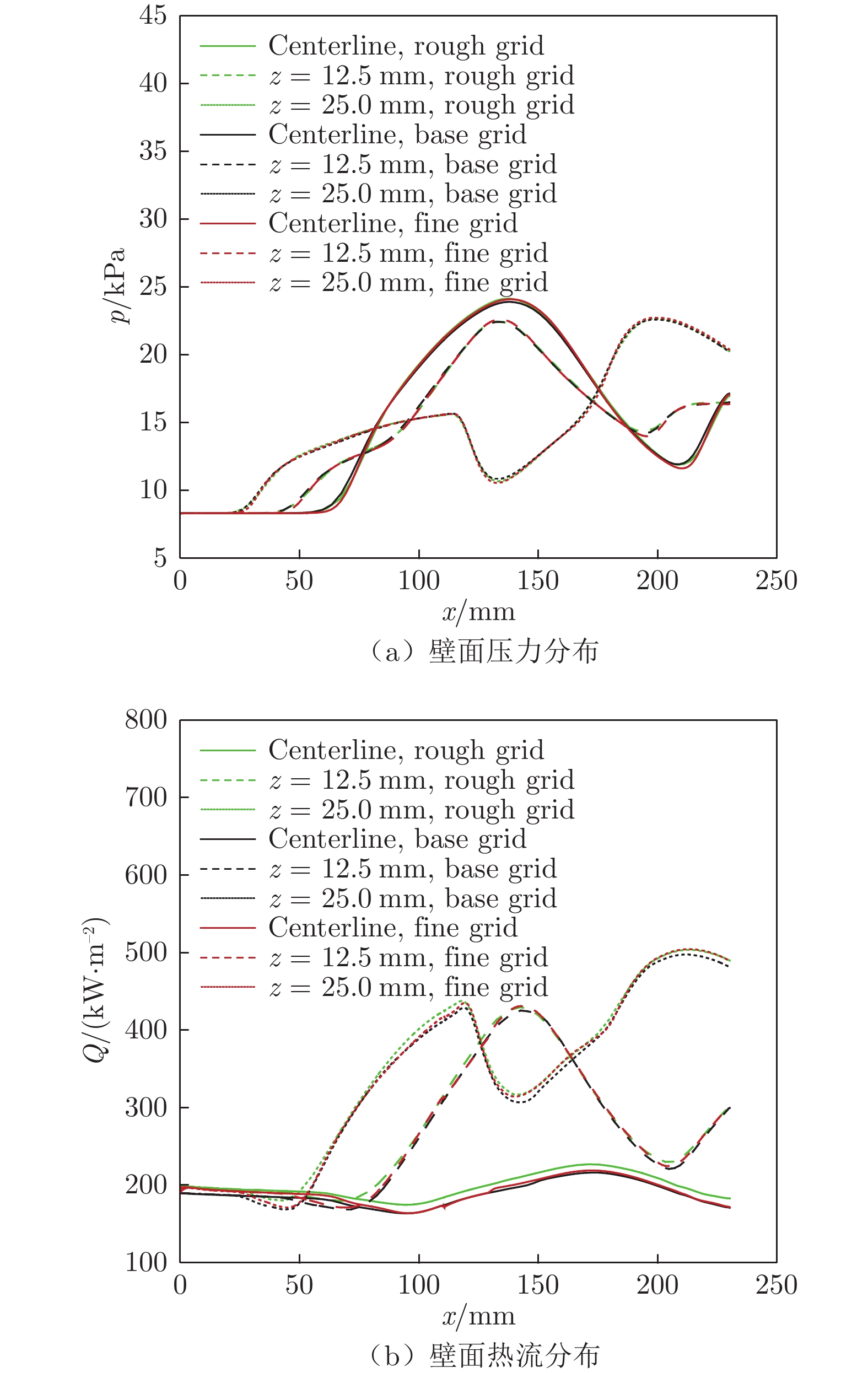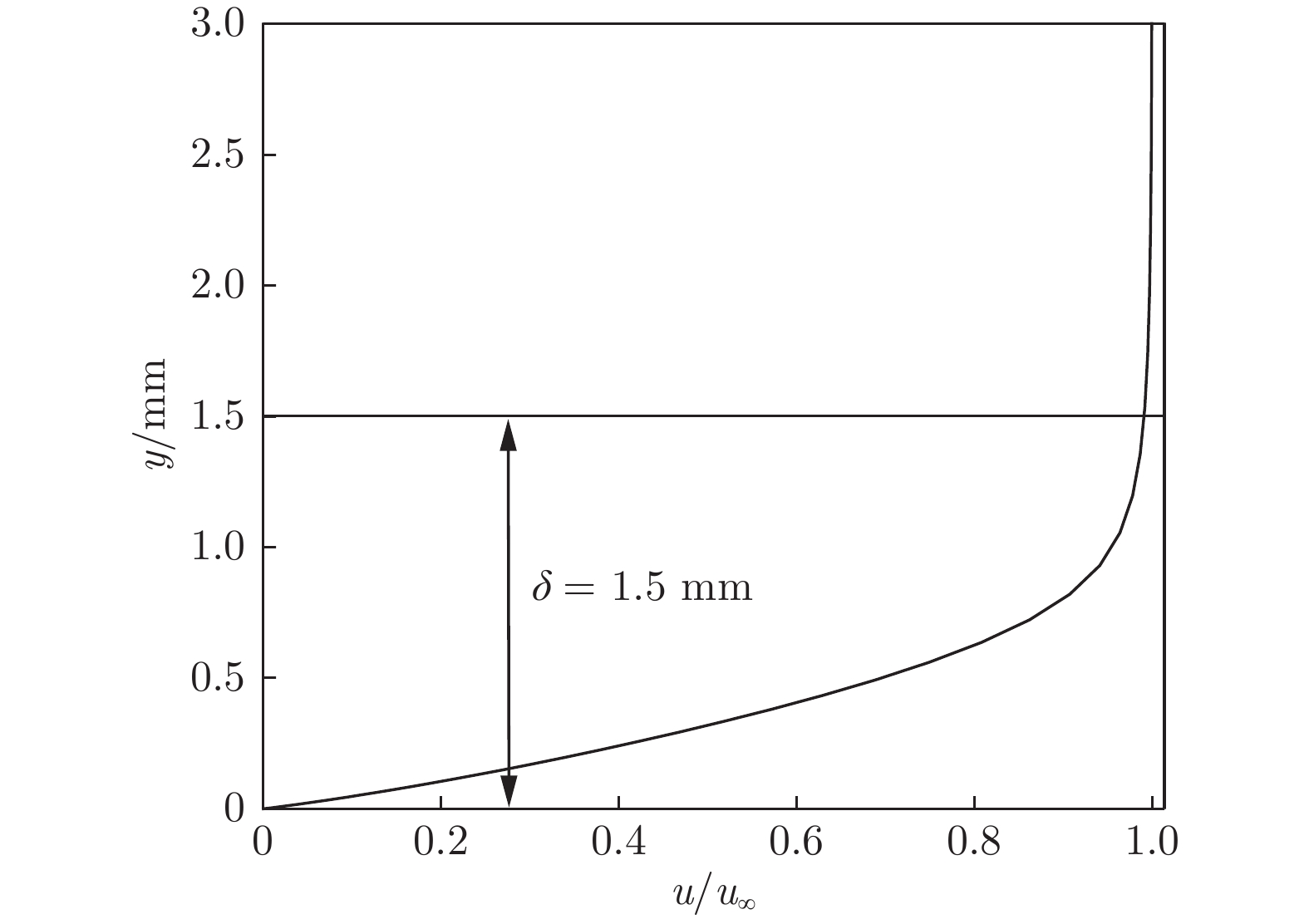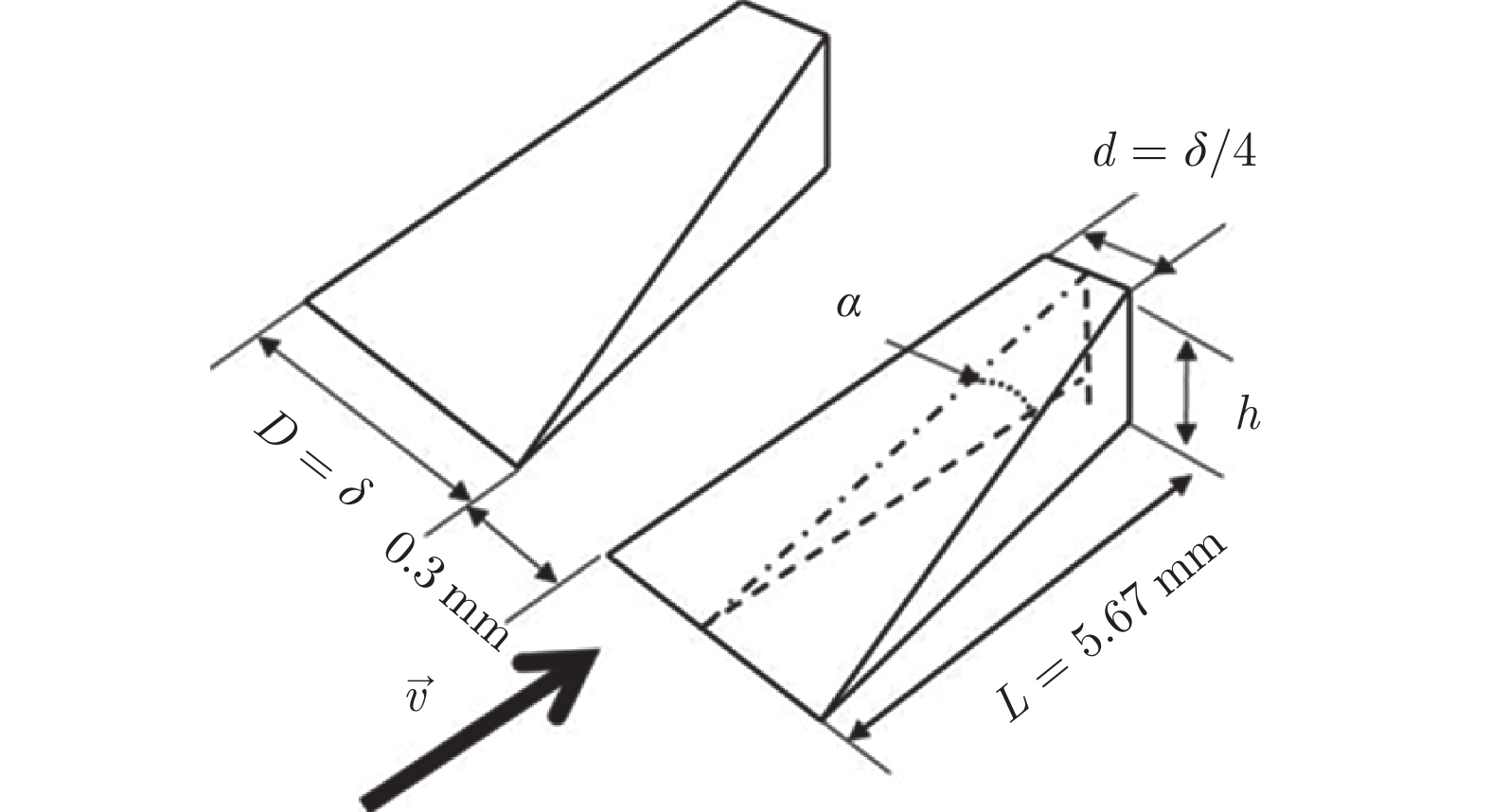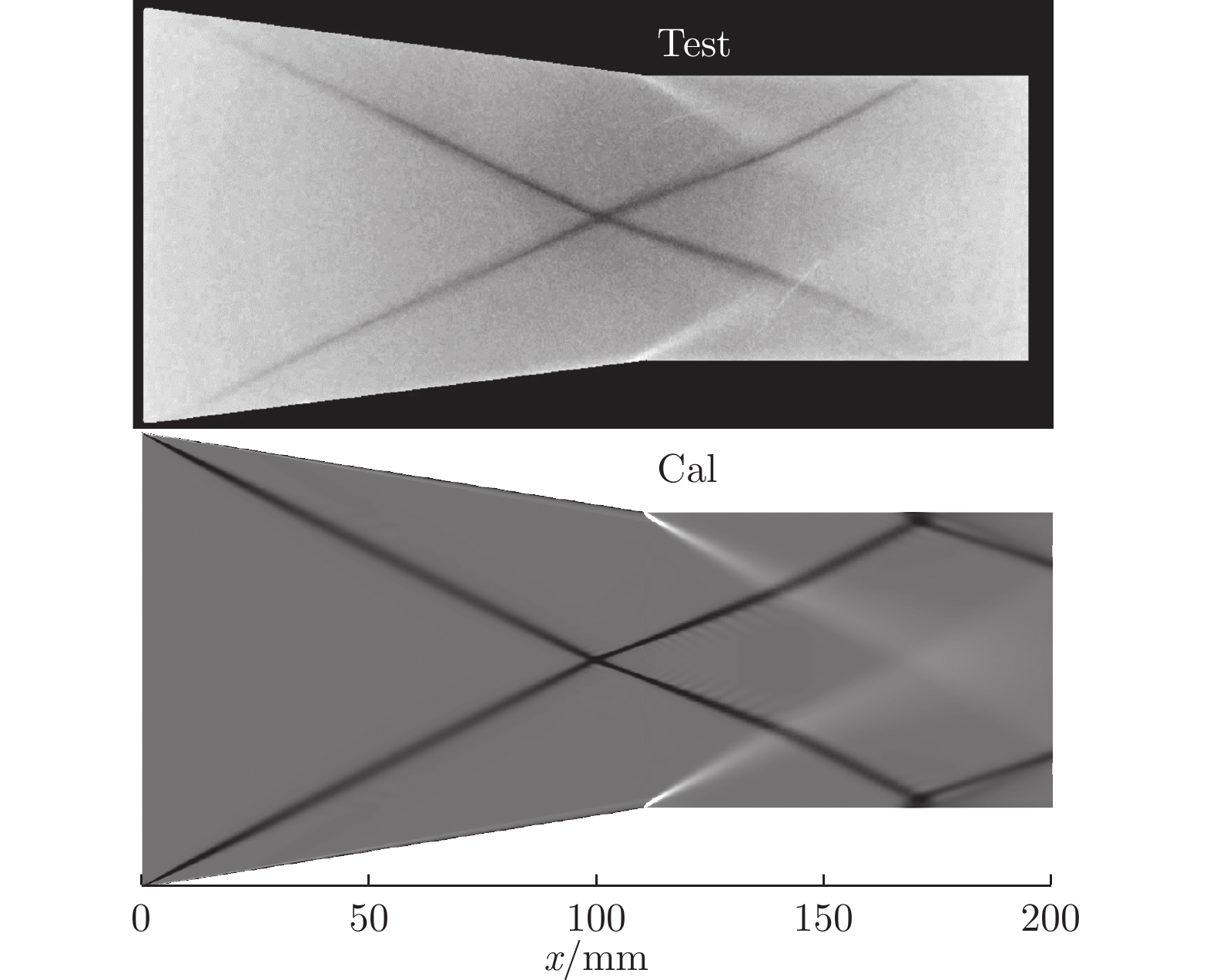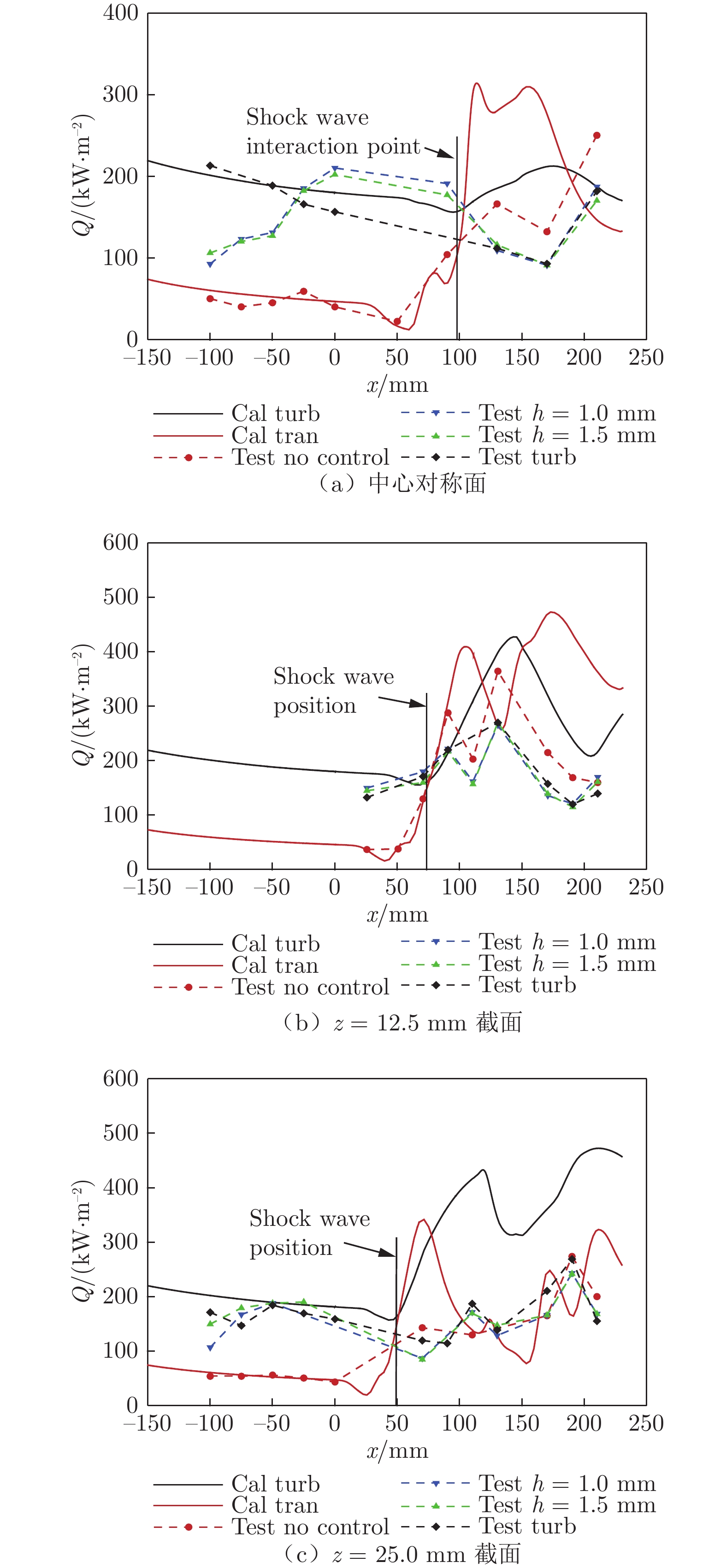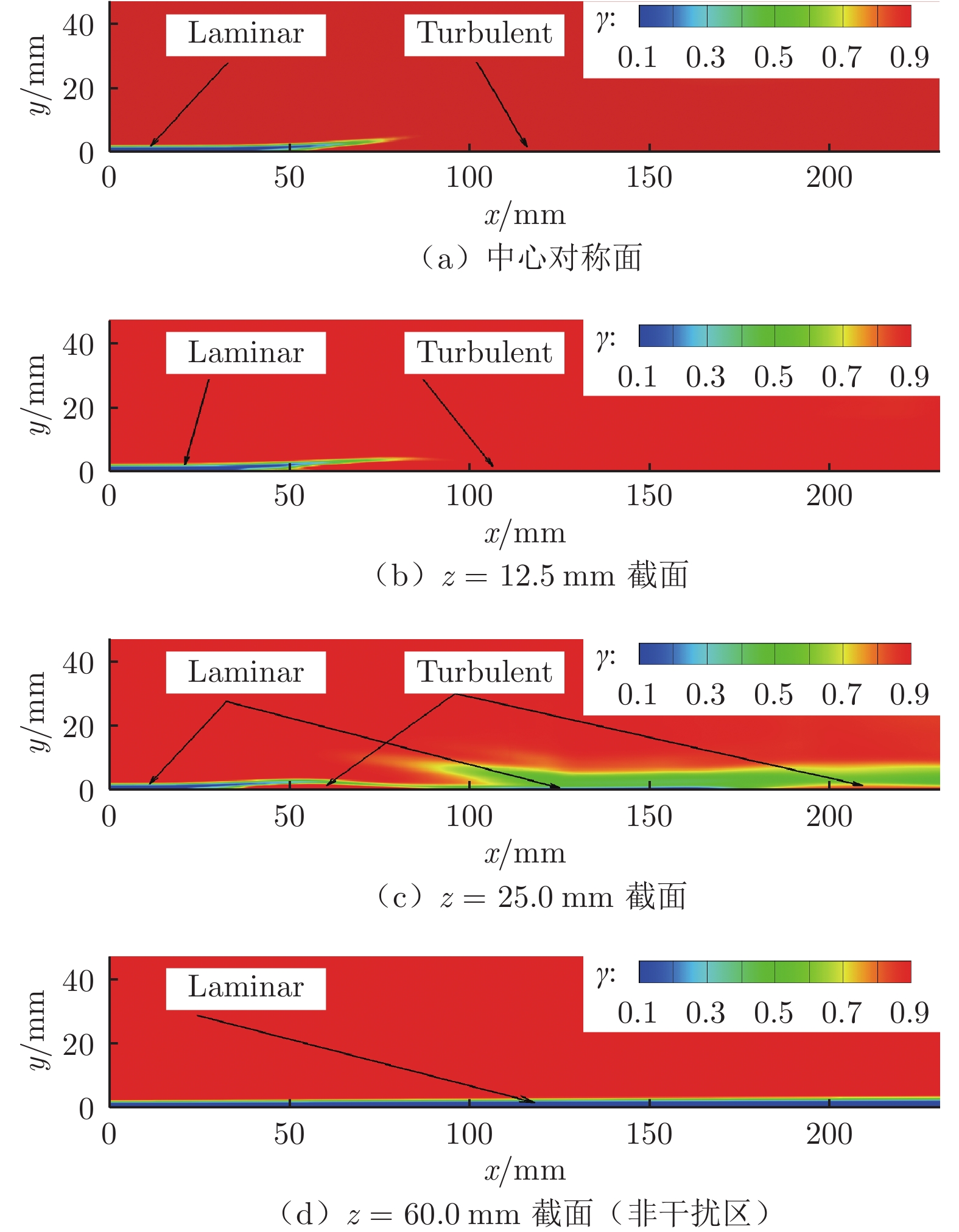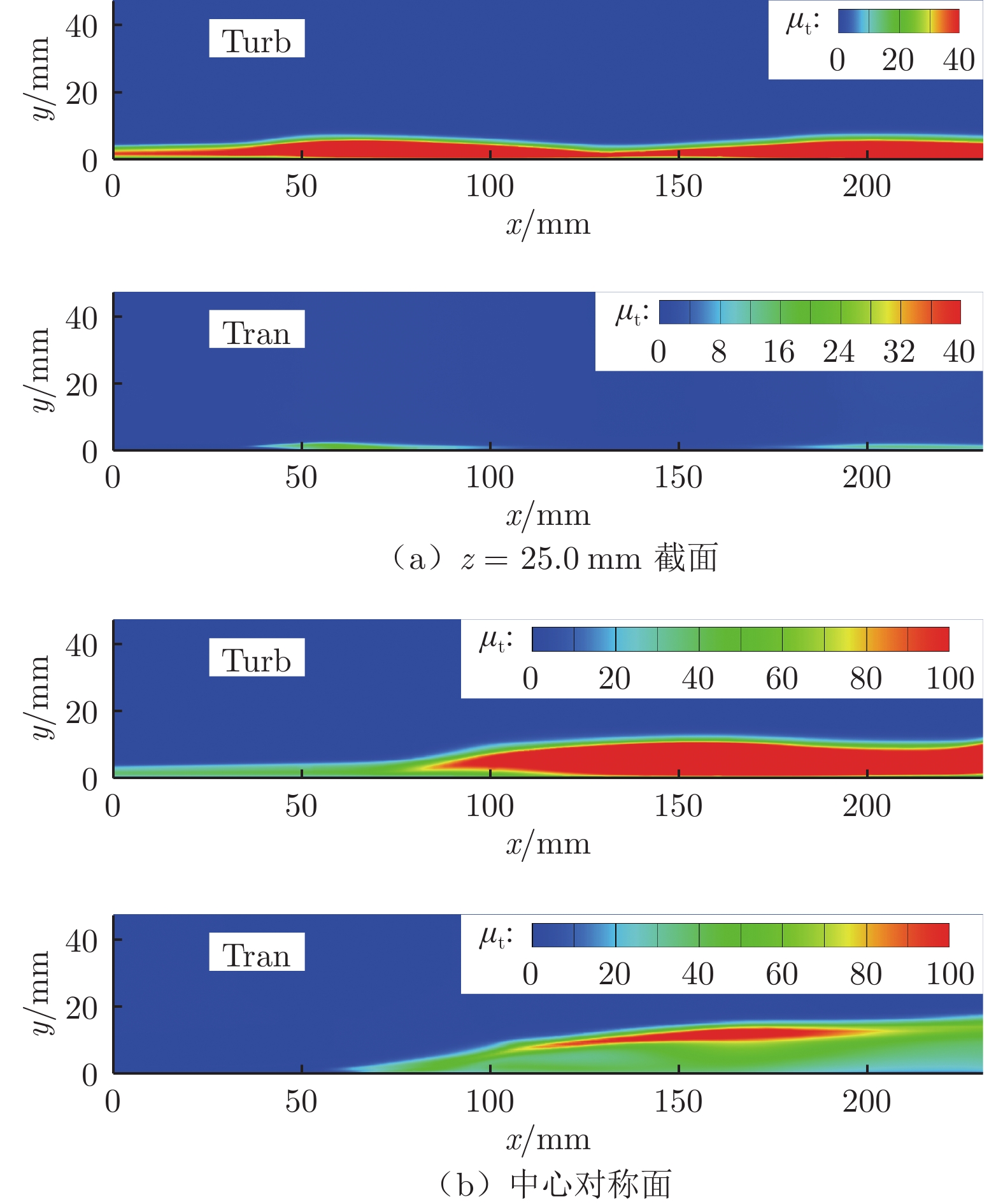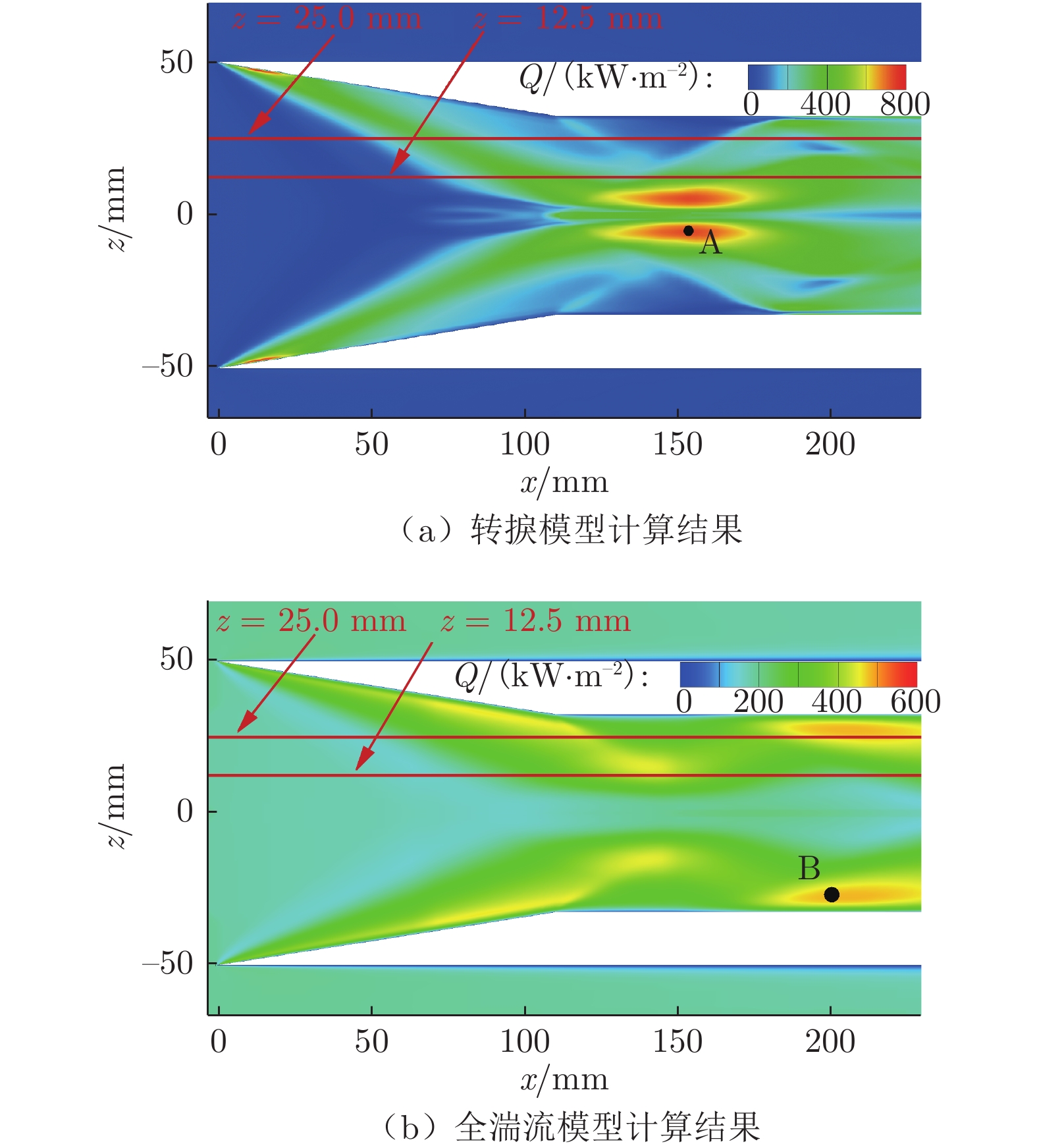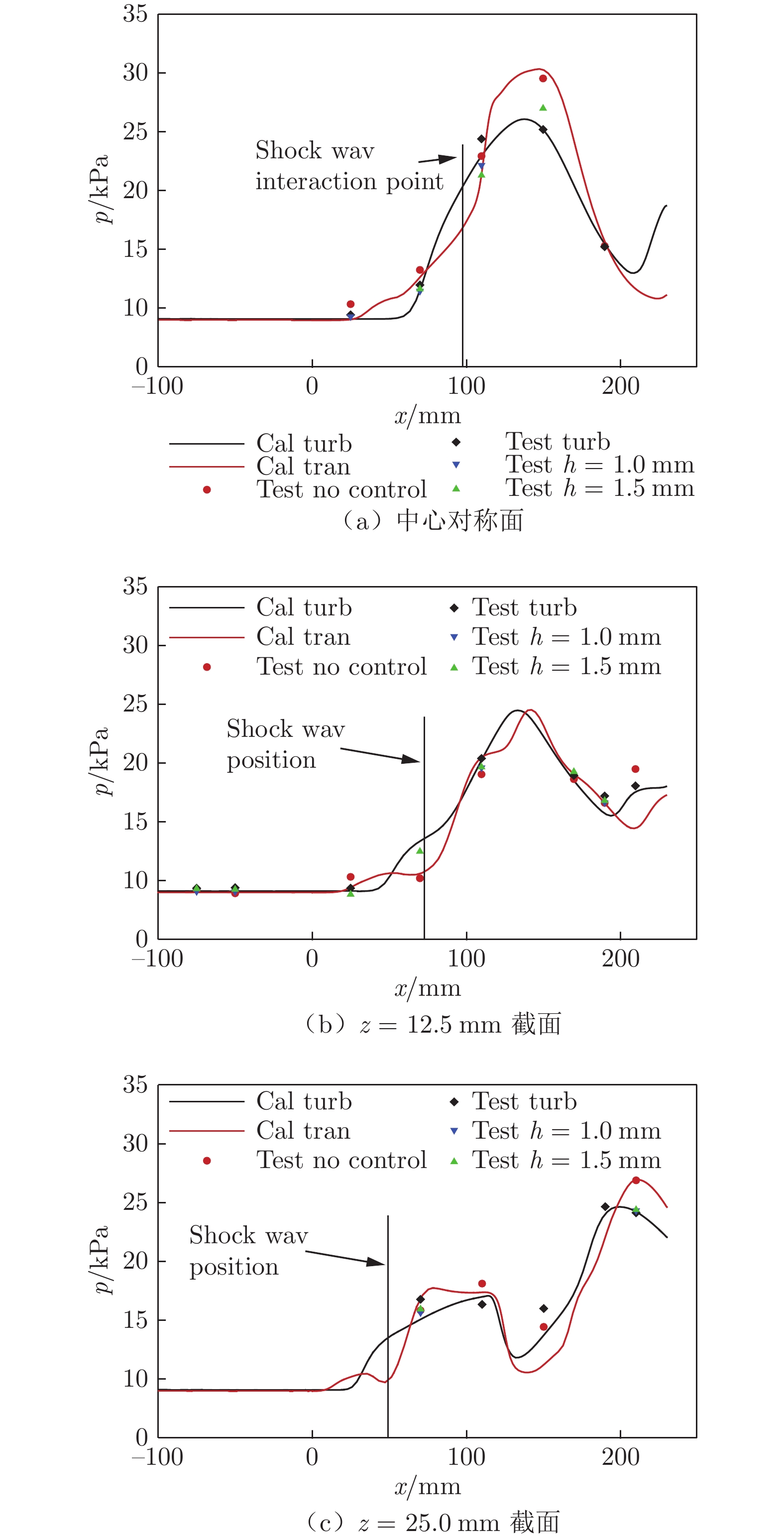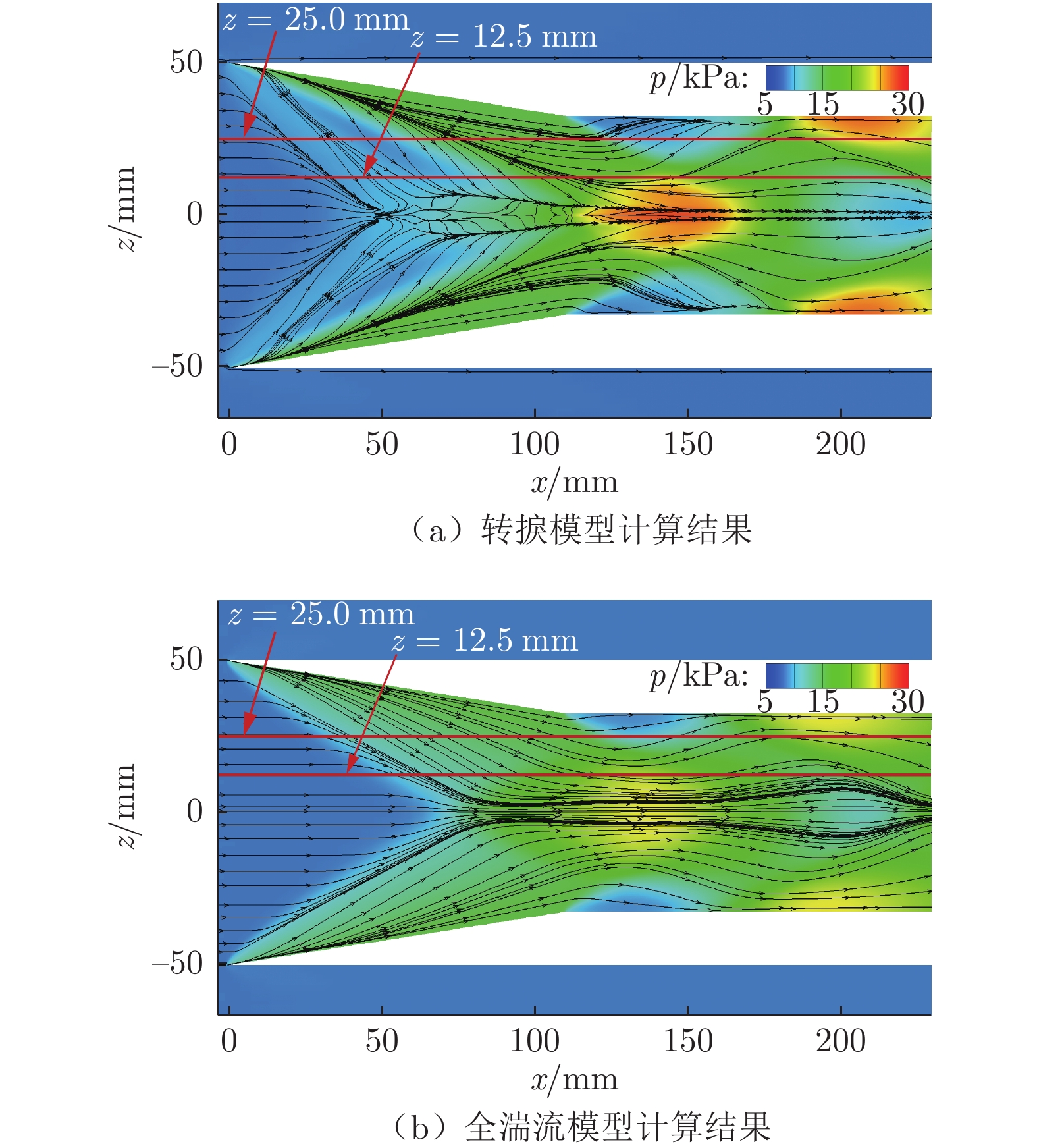Crossing shock waves/transitional boundary layers interactions in the double vertical wedges configuration
-
摘要:
针对超声速双垂直楔构型产生的交叉激波与转捩边界层干扰现象,结合风洞试验与数值模拟进行了深入研究。试验在中国空气动力研究与发展中心Φ600 mm脉冲燃烧风洞中开展,来流马赫数3.0,单位雷诺数2.1 × 106 m−1,获得了流场纹影、壁面压力和壁面热流。结果表明:受交叉激波逆压梯度作用,层流边界层在激波交汇附近分离,并在干扰区迅速转捩;在上游安装斜坡型涡流发生器或粗糙带,诱导边界层在干扰前转捩为湍流,分离区被有效抑制,干扰区热流明显下降(热流峰值下降超过25%)。数值模拟和风洞试验得到的激波结构、壁面压力吻合良好,但壁面热流计算值明显大于试验值。对比转捩模型和湍流模型计算结果发现:明显偏高的湍流黏性系数是RANS方法在非分离区过高预测干扰区热流的主要原因。
Abstract:Study on crossing shock waves/transitional boundary layer interaction in the double vertical wedges configuration was carried out using wind tunnel tests and numerical calculations. The wind tunnel tests were carried out at Φ600 mm pulse combustion wind tunnel. The Mach number of the free stream condition is 3.0, and the unit Reynolds number is 2.1 × 106 m−1. The schlieren images, wall pressure and wall heat fluxes were obtained during the tests. The results show that because of the adverse pressure gradient caused by the crossing shock waves, the separation of the laminar boundary layer was captured near the shock waves intersection point. And the transition from laminar to turbulent occurred rapidly in the interaction region. After installation of vertex generator devices or roughness devices, the boundary layer transition position moved to the upstream of the interaction region, the separation was effectively inhibited. And the heat fluxes in the interaction region declined obviously. The peak value of heat fluxes was reduced by more than 25%. The shock wave structures and wall pressure distributions obtained from tests and simulations agreed well, while the prediction heat fluxes were much larger than the test results. The comparison between the calculated results of the transition model and the turbulence model shows that the obviously larger turbulence viscosity is the main reason why RANS methods over-predict the heat fluxes in the unseparated interaction region.
-
0 引 言
高超声速边界层转捩作为空气动力学研究的前沿和热点问题,在学术和工程领域一直受到广泛的重视[1-3]。高超声速边界层转捩对飞行器表面摩阻、热流以及分离等问题有重要影响,从而对高超声速飞行器气动力/热性能产生显著影响,因此高超声速边界层问题是高超声速飞行器气动设计(特别是防热系统设计)需要重点关注的问题[4-8]。高超声速边界层转捩问题是空气动力学中还未解决的重大研究课题之一。目前在工程设计中,主要采用由试验数据总结出的半经验准则,另外基于线性稳定性理论的eN方法[9-10]在高超边界层转捩位置预测中有一定的效果。鉴于高超声速边界层转捩问题的复杂性,美国至20世纪70年代开始,采用空气动力学三大手段相结合的方式,做了大量研究工作,积累了大量的实验结果,也取得了一些成果[11]。近几年来国内也采用类似的手段开展研究[12-15],取得了很好的效果。
采用空气动力学三大手段研究高超声速边界层转捩问题,各有优缺点,风洞试验费用相对可承受,能提供转捩过程中多方面的细节数据,但不能复现飞行过程中情况;数值计算可提供全面边界层情况,但不能提供感受性和“breakdown”过程数据,强烈依赖数学模型;飞行试验能复现真实条件,但是费用太贵而不能太频繁开展飞行试验,并且只能获得相对有限的数据。因此地面风洞实验是高超声速边界层转捩预测的重要手段,但需要重点关注和研究天地差异问题。
美国在开展HiFiRE-5飞行试验工作[16]中指明,在高超声速边界层转捩研究中,地面风洞试验模拟飞行条件,应该主要关注自由来流扰动特征、马赫数、雷诺数、壁温比四个关键参数。但由于高超声速地面风洞实验设备模拟能力的限制,在进行高超声速边界层转捩地面风洞实验的过程中,难以完全复现实际飞行工况,常规高超声速风洞主要模拟马赫数、雷诺数,高超声速静音风洞主要模拟马赫数、来流脉动(静音风洞雷诺数偏低),激波风洞主要模拟马赫数、雷诺数、壁温比(或来流总温)。即使保证马赫数、雷诺数、来流脉动特征这三个参数的完全模拟,通过地面风洞实验,在缩比模型上获得的边界层转捩实验结果与实际飞行情况下的转捩形态存仍在一定差异;甚至即使在保证模型尺寸完全相同,来流马赫数、雷诺数、来流脉动特征接近的不同风洞试验条件下,转捩位置也存在一定的差别,这主要是受到壁温比参数的影响。因此壁温比/温度是高超声速边界层转捩研究中需要引起重视的关键参数。
关于温度对边界层流态的影响,已经开展过很多的研究工作,国内外学者通常以壁温比(壁温/总温,Tw/T0)表示壁面温度特征,开展壁温比对高超声速边界层转捩的影响研究。Kimmel等[17]认为地面风洞试验的壁温比对转捩研究非常重要,除了卡尔斯本(CUBRC)的风洞,其他地面风洞无法复现飞行试验壁温比;同时该文献研究了壁面冷却对高超声速边界层转捩的影响,研究结论为壁面冷却增加第2模态波不稳定性、降低横流转捩雷诺数。文献[16]证明由于风洞试验壁温比大,飞行试验壁温比小,增大壁温比会降低2模态波不稳定性,风洞试验中相对较温暖的壁面导致转捩延迟。Gosse等[18]认为,壁面冷却通过降低边界层厚度和横流比例的方式降低转捩雷诺数。Mack[19-20]和 Malik[21]等研究壁温对高超声速边界层转捩的影响,发现降低壁面温度使第1模态波更稳定,第2模态波更不稳定。但也有相矛盾的数据出现,有文献[22-24]表明降低壁面温度会出现转捩雷诺数增大、减小、基本不变甚至反转等情况。目前大部分研究工作都认为,对于第2模态波主导的边界层流动,降低壁面温度(即降低壁温比)会使得转捩位置提前。
国内外很多学者在开展温度对边界层转捩的影响研究时,往往将壁温比作为一个整体因素开展理论分析和试验研究。而赵金山等[25]研究证明,壁温比这一组合参数开展温度对高超声速边界层转捩的影响研究是不够充分和清晰的,壁面温度和来流温度对高超声速边界层转捩的影响应该被分开为两个独立的因素开展研究。其中在来流马赫数、雷诺数、湍流脉动强度、壁温完全相同条件下,随着来流总温升高,相同流向站位的速度、温度剖面逐渐饱满,进而对不稳定扰动波的抵抗能力增强;边界层底层的无量纲湍动能逐渐减小,对边界层基本流的扰动减弱,且不稳定扰动波在来流温度升高的作用下,经历了更长的衰减过程,导致扰动幅值降低,进而使得边界层内湍动能减小,对边界层基本流的扰动减弱;转捩起始位置随来流温度升高不断后移,转捩区长度缩短。
上述通过理论和数值计算研究得出的关于“来流总温对边界层转捩影响”的结论,其对应条件可在风洞试验中复现。因此本文尝试设计风洞试验方案,在来流马赫数、雷诺数、来流噪声水平、壁温大致相同条件下,采用点热流传感器测量转捩位置和高频脉动压力传感器测量边界层脉动特性的方法,研究风洞总温(即流场静温)对高超声速边界层转捩的影响,并采用γ−Reθ−MT修正模型的转捩预测和线性稳定性结果与试验结果进行对比分析。
1 风洞试验方案及计算方法简介
1.1 激波风洞试验方案简介
激波风洞可复现飞行条件壁温比,通过试验模拟获得较高的来流总温。激波风洞依靠高低压段压力差形成的运动激波,对低压段气体进行加热加压,在滞止区获得的瞬态高温高压气源,经过拉瓦尔喷管膨胀进入试验段从而建立高超声速流场。因此高温高压气源的获得主要依靠激波管中运动激波,由激波管运行原理可知,高低压段压力比决定总温,高低压段的压力都可以影响总压,总温总压参数只由高低压段压力数值和比值确定,且是相互耦合的。本次试验需要保持来流马赫数、雷诺数、湍流脉动强度、壁温大致相同条件下,改变来流总温。对于高超声速地面风洞来说,来流马赫数和噪声水平基本由相应马赫数条件的喷管决定,壁温维持室温条件,流场雷诺数是需要重点关注的对象。由雷诺数公式可知,要保持雷诺数大致相同,流场总温升高,黏性系数跟随变化,对应流场总压也需要增大。为了满足本文中试验流场条件需求,对激波风洞总温总压模拟能力和流场数据库进行分析,最终采用预算并经过流场调试的方式,确定本次试验的一个高总温流场和一个低总温流场如下表所示,基本满足本次试验的需求。
关于试验条件设置,为了保证单位雷诺数一致,同时改变风洞来流的总压和总温,研究总温变化导致的壁温比变化对高超边界层转捩的影响,目前一般认为风洞总压变化导致的流场密度变化对边界层稳定性的影响不明显。正如文献综述中提到[16],地面风洞试验研究高超边界层转捩主要关注马赫数、雷诺数、来流噪声、壁温比,而以前关于壁温比的研究工作主要关注壁温变化,本文尝试通过改变来流总温研究其对高超边界层转捩的影响。
试验模型为图示尖锥模型(图1),半锥角7°,头部钝度为0.05 mm,理论尖点距模型底部长度为800 mm,攻角为0°。模型材质为30CrMnSiA合金钢,内部空心,壁厚3~8 mm,在壁面安装铂电阻热流传感器测量壁面热流以分析边界层转捩情况,安装PCB 132B38型高频脉动压力传感器测量脉动压力以分析边界层稳定性情况。在下表面中心线上,从X = 125 mm(坐标原点在尖锥模型理论尖点,X为模型轴向,顺流向方向为正)开始,在模型表面安装32个热流传感器(间隔20 mm)。在侧面水平线上,从X = 125 mm(X为模型轴向)开始,在模型表面安装8个PCB脉动压力传感器(间隔80 mm)。本次风洞试验采用的铂电阻热流传感器和PCB高频脉动压力传感器测试原理及其余试验/模型细节可参见文献[26-27]。本文中激波风洞流场有效测试时间在8 ms左右,对于开展高超声速气动热试验和边界层转捩试验来说,8 ms运行时间已经足够,配套的热流传感器响应速度在微秒量级、数据采集系统采样频率1 MHz。关于热流传感器测试信号所反映的典型边界层转捩情况见笔者2019年发表的文章[26]。本次试验风洞来流噪声水平约为4.5%[26],壁面温度为室温300 K。
1.2 本文采用计算方法简介
为了对试验结果进行分析,本文首先采用基于γ−Reθ−MT修正转捩模型的RANS方法数值计算结果与试验测量热流分布结果进行了对比,分析了边界层转捩位置及壁面热流分布结果;然后采用线性稳定性理论eN方法与试验测量脉动压力结果进行了对比,分析了第2模态不稳定波频谱分布的变化情况。
本文采用有限体积方法离散求解三维直角坐标系下的完全气体Navier−Stokes方程,转捩模型采用γ−Reθ−MT模型。通过对网格控制体单元内的无黏通量与黏性通量进行积分,同时结合Gauss定理,将耗散大的矢通量分裂格式Steger−Warming格式与耗散小的基于解析黎曼求解器的Godunov格式混合使用以提高计算稳定性,同时使格式在边界层模拟中具有低耗散特性。无黏项采用隐式格式,黏性项采用显式二阶中心格式,最后采用LU−SGS(Lower−Upper Symmetric−Gauss−Seidel)方法进行时间推进求解,并使用局部时间步长加速计算收敛。物面采用无滑移等温壁条件,壁面温度Tw = 300 K;自由来流参数如表1所列,出口边界采用超声速外推边界。特别值得指出的是,由于在风洞试验中,模型位于流场核心区内,且气流方向与模型中心线完全一致,因此为节省计算量,本文仅采用半模开展了数值模拟。网格数为201(流向) × 51(周向) × 201(法向),且为保证边界层内流动结构的模拟,在靠近壁面附近进行了网格加密。
表 1 风洞来流参数Table 1 Wind tunnel incoming flow parameters高总温 低总温 总压P0(MPa) 22.54 12.05 总温T0(K) 1332.2 956.6 马赫数Ma 9.86 9.97 单位雷诺数Re∞/L(1/m) 8.90 × 106 8.40 × 106 密度ρ∞(kg/m3) 0.026 0.0199 静温T∞(K) 69.4 47.3 静压P∞(Pa) 529.8 279 速度u∞(m/s) 1674 1397 线性稳定性理论(LST)在本文主要用于对比分析风洞试验的高频脉动压力数据。该方法首先通过采用直接数值模拟方法获得基本流场,然后在此基础上通过求解线性稳定性方程获得不稳定波的频谱特征,并通过结合eN方法,得到表征扰动幅值沿流向放大倍数的N值。计算工况见表1,计算外形见图1,选择二维半圆锥模型。数值方法为黏性项采用六阶中心差分,无粘项经L−F格式通量分裂后采用五阶WENO和五阶迎风差分,时间项采用三阶R−K推进。边界条件为极轴上单边插值、出口采用三阶外推法、壁面为300 K等温条件、上边界为来流条件。在计算基本流场时,选择流向网格 × 法向网格为601 × 351。流向网格在头部附近较密,然后向下游逐渐放稀;法向网格在激波附近加密,并且基本平行与激波线,同时在边界层区域加密保证至少100个网格点。当基本流场定场后,将其坐标变换到贴体坐标(ξ, η)并通过流场插值获得贴体矩形网格流场,用于流动稳定性与eN分析。
2 表面热流/转捩位置结果对比
风洞试验采用铂电阻热流传感器测量获得了尖锥模型母线热流分布变化情况,同时采用γ−Reθ−MT修正转捩模型的数值计算方法在背靠背条件下、计算了相同工况模型表面热流分布情况,图2给出了在高低两个不同总温流场条件下的试验测量和数值计算获得的尖锥模型表面热流分布情况。从图中可以看出,除了湍流阶段数值计算结果稍微偏低之外,数值计算结果与试验测量结果吻合较好,包括转捩开始位置也大致相符。试验测量和数值计算反映了该尖锥模型在激波风洞如表1所示流场条件下热流分布情况,这是典型的边界层转捩条件下热流分布,边界层转捩位置大约在X = 262~279 mm之间, 沿流向在层流区域热流单调下降、转捩区热流升高、湍流区热流下降。
对试验测量结果进行分析,发现高总温流场转捩开始位置与低总温情况差别不大,或者说无法判断两种转捩开始位置谁更靠前,再加上热流测量结果重复性误差相对较大( ± 10%),因此不能简单由图2试验结果得出转捩位置比较结果。而采用γ−Reθ−MT修正转捩模型计算得到的热流分布曲线显示,高总温流场转捩开始位置约为X = 262~267 mm,低总温流场转捩开始位置为X = 273~279 mm,前者转捩位置稍提前于后者,但差距不大。需要说明的是,图2中结果是热流传感器测量获得的绝对热流,可以看出,虽然两个流场马赫数雷诺数基本相同,但高总温流场测点热流大约为低总温流场热流的2.5~3.2倍,而两个流场条件下球头驻点(假设存在一定半径球头,本次试验模型球头半径0.05 mm)热流计算(F−R公式)结果约为2.3倍。
3 压力脉动特性及线性稳定性分析
图3~图4给出了高低总温流场条件下的2#~6#PCB传感器测量的压力脉动功率谱,其中f ≈ 200~500 kHz之间为第2模态波频率范围。与前期开展的工作相比[26-27],8只PCB传感器展示了典型的层流−转捩−湍流边界层压力脉动功率谱特性,其中1#~2#PCB传感器在层流区,3#~5#在转捩过渡区,6#~8#在湍流区(如表2所示),随着边界层向下游发展,第2模态波主导频率逐渐降低,幅值先增大后减小;并且可以看出高低总温两个流场的脉动压力功率谱特性基本一致。
为了认识风洞总温对边界层转捩的影响规律,首先利用稳定性理论和转捩eN方法[9-10]分析高低总温的边界层稳定性机制。图5给出高低总温工况下中性曲线对比。可以看出,高总温的边界层第2模态增长率比低总温的高,频率也比低总温的高,导致高总温的N值比低总温的大,如图6和图7所示。以ξ = 0.7 m为例,高总温的N值达到8以上,对应最不稳定频率为251.4 kHz;而低总温的N值为7.2,对应最不稳定频率为176.9 kHz,说明总温越高,边界层第2模态越不稳定,频率越高,但是由于两者N值相差不太大,预计高总温的转捩位置相比低总温提前的幅度也不会大,与图2的试验对比结果一致。
表 2 PCB传感器坐标及当地边界层流态Table 2 PCB sensor coordinates and local boundary layer flow regimesPCB 1# 2# 3# 4# 5# 6# 7# 8# X(mm) 125 205 285 365 445 525 605 685 流态 L L R R R T T T 将线性稳定性理论计算结果与试验结果比较,采用线性稳定性理论eN方法获得了不同频率扰动的N值分布,由N值分布可确定第2模态波主导扰动频率,传感器压力脉动功率谱峰值频率即所测量的第2模态波主导扰动频率,两者应该基本一致。图8~图12分别给出了高低总温两个流场的2#~6#传感器压力脉动功率谱与线性稳定性分析N值对比结果,从图中可以看出,测量结果和理论分析给出的频率基本吻合。其中2#传感器安装位置为X = 205 mm,本次试验两个流场工况条件下该区域边界层都是层流状态,属于边界层不稳定波发展阶段,其幅值逐渐增大,图8中压力脉动功率谱结果可以看出,试验传感器捕捉到第2模态脉动信息。3#~5#传感器位于转捩过渡区,其位置分别为X = 285 mm、X = 365 mm、X = 445 mm,其中3#传感器位于转捩开始区域、5#传感器接近转捩完成区域,图9~图11显示传感器捕捉到第2模态脉动信息;图3和图4中可以看出,从3#到5#传感器,第2模态脉动幅值先增大后减小。如图12所示,6#安装在X = 525 mm,此时流动为湍流状态,传感器已经开始不能捕捉到第2模态信息。
4 结 论
在中国空气动力研究与发展中心的Φ2m 激波风洞(FD−14A)中,采用点热流传感器测量转捩位置和高频脉动压力传感器测量边界层脉动特性的方法,研究了风洞总温(即流场静温)对高超声速边界层转捩的影响,并与γ−Reθ−MT修正模型的转捩预测和线性稳定性结果进行了对比。
1) 在来流马赫数、雷诺数、来流噪声水平、壁温大致相同条件下,试验测量的热流分布结果显示,T0 = 1332 K的高总温流场和T0 = 957 K的低总温流场边界层转捩位置相差不明显;而从γ−Reθ−MT修正转捩模型计算结果和线性稳定性理论分析结果显示两个工况转捩位置有差距,但相差不大,高总温流场边界层转捩位置稍早于低总温流场。
2) 本次数值计算工作在背靠背条件下、采用γ−Reθ−MT修正模型转捩预测方法计算的尖锥模型热流分布结果与风洞试验结果吻合良好,转捩位置也基本一致,本文工作给该转捩模型数值计算方法的可信度提供一个例证。
3)压力传感器测量的压力脉动频谱特性和线性稳定性理论分析结果相互印证,展示了风洞条件下高低总温两个流场第2模态波频谱特性。
值得指出的是,在实际地面风洞试验条件下,来流马赫数、雷诺数、来流噪声等参数无法保证完全一致,叠加风洞运行参数不确定性和试验测量误差等因素,可能是导致的本次试验结果差别不明显的原因。在后续研究过程中,将从两方面进一步深入研究,一是研究风洞试验转捩位置不确定度问题,分析风洞运行及热流传感器测量对转捩位置不确定度的影响;二是提升总温总压差别,继续开展来流总温对边界层转捩影响的试验研究。
-
表 1 试验来流条件
Table 1 Freestream condition of the test
马赫数 总温
Tt/K总压
pt/MPa单位雷诺数
Re/(106 m−1)来流组分摩尔比
O2∶N2∶H2O比热比 3.0 1350 0.335 2.1 0.21∶0.56∶0.23 1.34 表 2 x > 0区域x、y、z方向上网格数
Table 2 Grid numbers in x, y, z directions in the x > 0 area
网格 nx ny nz 粗网格(rough) 141 81 71 基准网格(base) 201 121 101 细网格(fine) 401 181 151 -
[1] 吴瀚, 王建宏, 黄伟, 等. 激波/边界层干扰及微型涡流发生器控制研究进展[J]. 航空学报, 2021, 42(6): 025371. DOI: 10.7527/S1000-6893.2021.25371 WU H, WANG J H, HUANG W, et al. Research progress on shock wave/boundary layer interactions and flow controls induced by micro vortex generators[J]. Acta Aeronautica et Astronautica Sinica, 2021, 42(6): 025371. doi: 10.7527/S1000-6893.2021.25371
[2] 张悦, 谭慧俊, 王子运, 等. 进气道内激波/边界层干扰及控制研究进展[J]. 推进技术, 2020, 41(2): 241–259. DOI: 10.13675/j.cnki.tjjs.190376 ZHANG Y, TAN H J, WANG Z Y, et al. Progress of shock wave/boundary layer interaction and its control in inlet[J]. Journal of Propulsion Technology, 2020, 41(2): 241–259. doi: 10.13675/j.cnki.tjjs.190376
[3] GARRISON T J, SETTLES G S. Flowfield visualization of crossing shock-wave/boundary-layer interactions[C]//Proc of the 30th Aerospace Sciences Meeting and Exhibit. 1992: 750. doi: 10.2514/6.1992-750
[4] THIVET F. Lessons learned from RANS simulations of shock-wave/boundary-layer interactions[R]. AIAA 2002-0583. doi: 10.2514/6.2002-583
[5] 赵慧勇, 雷波, 乐嘉陵. 非对称交叉激波和湍流边界层相互作用的数值研究[J]. 航空动力学报, 2009, 24(10): 2183–2188. DOI: 10.13224/j.cnki.jasp.2009.10.009 ZHAO H Y, LEI B, LE J L. Numerical investigation of interaction between asymmetric crossing shock waves/turbulence boundary layer[J]. Journal of Aerospace Power, 2009, 24(10): 2183–2188. doi: 10.13224/j.cnki.jasp.2009.10.009
[6] ZHELTOVODOV A A, MAKSIMOV A I, SHEVCHENKO A. Topology of three-dimensional separation under the conditions of symmetric interaction of crossing shocks and expansion waves with turbulent boundary layer[J]. Thermo-physics and Aeromechanics, 1998, 5(3): 293–312.
[7] ZHELTOVODOV A A, MAKSIMOV A I, GAITONDE D, et al. Experimental and numerical study of symmetric interaction of crossing shocks and expansion waves with a turbulent boundary layer[J]. Thermophysics and Aero-mechanics, 2016, 23(2): 155–171.
[8] ZHELTOVODOV A A, MAKSIMOV A I. Hypersonic crossing shock-waves/turbulent boundary layer interaction[R]. ADA363672. 1999.
[9] ZHELTOVODOV A A, MAKSIMOV A I, SCHÜLEIN E, et al. verification of crossing-shock wave/boundary layer inter-action computations with the k–ε turbulence model[C]// Proc of the 10th International Conference on Methods of Aerophysical Research. 2000: 231–241.
[10] 霍格尔·巴宾斯基, 约翰·K. 哈维. 激波边界层干扰[M]. 白菡尘, 译. 北京: 国防工业出版社, 2015. BABINSKY H, HARVEY J K. Shock wave-boundary-layer interactions[M]. translated by BAI H C. Beijing: National Defense Industry Press, 2015.
[11] KNIGHT D, MORTAZAVI M. Hypersonic shock wave transitional boundary layer interactions - A review[J]. Acta Astronautica, 2018, 151: 296–317. doi: 10.1016/j.actaastro.2018.06.019
[12] TOKURA Y, MAEKAWA H. DNS of a spatially evolving transitional/turbulent boundary layer with impinging shock wave[C]//Proc of the 49th AIAA Aerospace Sciences Meeting including the New Horizons Forum and Aerospace Exposition. 2011: 729. doi: 10.2514/6.2011-729
[13] DAVIDSON T S C, BABINSKY H. Transition location effects on normal shock wave: boundary layer interactions[C]//Proc of the 53rd AIAA Aerospace Sciences Meeting. 2015: 1975. doi: 10.2514/6.2015-1975
[14] POLIVANOV P A, SIDORENKO A A, MASLOV A A, et al. Transition effect on shock wave/boundary layer inter-action at M = 1.47[C]// Proc of the 53rd AIAA Aerospace Sciences Meeting. 1974.
[15] THREADGILL J A, LITTLE J C, WERNZ S H. Transitional shock wave boundary layer interactions on a compression ramp at Mach 4[C]//Proc of the AIAA Scitech 2019 Forum. 2019: 0343. doi: 10.2514/6.2019-0343
[16] 武宇. 超声速压缩拐角流动机理及其流动分离控制的试验研究[D]. 长沙: 国防科学技术大学, 2015. WU Y. Experimental investigation of supersonic flow over A compression ramp and its flow control on separation[D]. Changsha: National University of Defense Technology, 2015.
[17] 武宇, 易仕和, 陈植, 等. 超声速层流/湍流压缩拐角流动结构的实验研究[J]. 物理学报, 2013, 62(18): 316–327. DOI: 10.7498/aps.62.184702 WU Y, YI S H, CHEN Z, et al. Experimental investigations on structures of supersonic laminar/turbulent flow over a compression ramp[J]. Acta Physica Sinica, 2013, 62(18): 316–327. doi: 10.7498/aps.62.184702
[18] 童福林, 唐志共, 李新亮, 等. 压缩拐角激波与旁路转捩边界层干扰数值研究[J]. 航空学报, 2016, 37(12): 3588–3604. DOI: 10.7527/S1000-6893.2016.0096 TONG F L, TANG Z G, LI X L, et al. Numerical study of shock wave and bypass transitional boundary layer interaction in a supersonic compression ramp[J]. Acta Aeronautica et Astronautica Sinica, 2016, 37(12): 3588–3604. doi: 10.7527/S1000-6893.2016.0096
[19] 童福林, 李新亮, 唐志共, 等. 转捩对压缩拐角激波/边界层干扰分离泡的影响[J]. 航空学报, 2016, 37(10): 2909–2921. DOI: 10.7527/S1000-6893.2015.0355 TONG F L, LI X L, TANG Z G, et al. Transition effect on separation bubble of shock wave/boundary layer interaction in a compression ramp[J]. Acta Aeronautica et Astronautica Sinica, 2016, 37(10): 2909–2921. doi: 10.7527/S1000-6893.2015.0355
[20] 童福林, 李新亮, 段焰辉. 超声速压缩拐角激波/边界层干扰动力学模态分解[J]. 航空学报, 2017, 38(12): 121376. DOI: 10.7527/S1000-6893.2017.121376 TONG F L, LI X L, DUAN Y H. Dynamic mode decomposition of shock wave and supersonic boundary layer interactions in a compression ramp[J]. Acta Aeronautica et Astronautica Sinica, 2017, 38(12): 121376. doi: 10.7527/S1000-6893.2017.121376
[21] 童福林, 李新亮, 唐志共. 激波与转捩边界层干扰非定常特性数值分析[J]. 力学学报, 2017, 49(1): 93–104. DOI: 10.6052/0459-1879-16-224 TONG F L, LI X L, TANG Z G. Numerical analysis of unsteady motion in shock wave/transitional boundary layer interaction[J]. Chinese Journal of Theoretical and Applied Mechanics, 2017, 49(1): 93–104. doi: 10.6052/0459-1879-16-224
[22] 解少飞, 宫建, 高波, 等. 边界层转捩与压缩拐角分离流动的非定常作用[J]. 空气动力学学报, 2017, 35(1): 129–135. DOI: 10.7638/kqdlxxb-2015.0104 XIE S F, GONG J, GAO B, et al. Unsteady interaction between transitional boundary layer and flow separation in compression corner[J]. Acta Aerodynamica Sinica, 2017, 35(1): 129–135. doi: 10.7638/kqdlxxb-2015.0104
[23] LE J L, LIU W, HE W, et al. Pulse combustion facility and its preliminary application in scramjet research[C]//Proc of the 11th International Conference on Methods of Aero-physical Research. 2002.
[24] 贺元元, 贺伟, 张小庆, 等. 燃烧加热脉冲风洞气动/推进一体化试验研究[J]. 推进技术, 2017, 38(8): 1741–1746. HE Y Y, HE W, ZHANG X Q, et al. Aero-propulsion integration test in combustion heated impulse facility[J]. Journal of Propulsion Technology, 2017, 38(8): 1741–1746.
[25] 刘初平. 气动热与热防护试验热流测量[M]. 北京: 国防工业出版社, 2013: 79–103. [26] 赵慧勇. 超燃冲压整体发动机并行数值研究[D]. 绵阳: 中国空气动力研究与发展中心, 2005. ZHAO H Y. Parallel numerical study of whole scramjet engine[D]. Mianyang: China Aerodynamics Research and Development Center, 2005.
[27] 易淼荣, 赵慧勇, 乐嘉陵. 基于γ–Reθ转捩模型的高超声速复杂构型转捩模拟[J]. 实验流体力学, 2018, 32(4): 1–11. DOI: 10.11729/syltlx20180019 YI M R, ZHAO H Y, LE J L. Hypersonic boundary layer transition simulation of complex configuration using γ–Reθ transition model[J]. Journal of Experiments in Fluid Mechanics, 2018, 32(4): 1–11. doi: 10.11729/syltlx20180019
[28] 韩亦宇. 高超声速进气道激波振荡的DES数值模拟研究[D]. 绵阳: 中国空气动力研究与发展中心, 2014. HAN Y Y. Detached eddy simulation (DES) of hypersonic inlet shock oscillation[D]. Mianyang: China Aerodynamics Research and Development Center, 2014.
[29] 易淼荣, 赵慧勇, 乐嘉陵, 等. 基于IDDES框架的γ–Reθ转捩模型[J]. 航空学报, 2019, 40(8): 122726. DOI: 10.7527/S1000-6893.2018.22726 YI M R, ZHAO H Y, LE J L, et al. γ–Reθ transition model based on IDDES frame[J]. Acta Aeronautica et Astronautica Sinica, 2019, 40(8): 122726. doi: 10.7527/S1000-6893.2018.22726
[30] 赵慧勇, 雷波, 乐嘉陵. 对称交叉激波和湍流边界层相互作用的数值研究[J]. 推进技术, 2010, 31(4): 406–411. DOI: 10.13675/j.cnki.tjjs.2010.04.011 ZHAO H Y, LEI B, LE J L. Numerical investigation of interaction between symmetric crossing shock waves/turbulence boundary layer[J]. Journal of Propulsion Technology, 2010, 31(4): 406–411. doi: 10.13675/j.cnki.tjjs.2010.04.011
[31] THIVET F, KNIGHT D D, ZHELTOVODOV A A, et al. Some insights in turbulence modeling for crossing-shock-wave/boundary-layer interactions[C]//Proc of the 38th Aerospace Sciences Meeting and Exhibit. 2000: 131. doi: 10.2514/6.2000-131







 下载:
下载:











